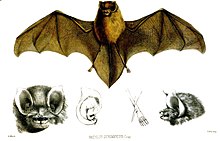Mexican funnel-eared bat
| Mexican funnel-eared bat | |
|---|---|

| |
| Scientific classification | |
| Domain: | Eukaryota |
| Kingdom: | Animalia |
| Phylum: | Chordata |
| Class: | Mammalia |
| Order: | Chiroptera |
| Family: | Natalidae |
| Genus: | Natalus |
| Species: | N. stramineus
|
| Binomial name | |
| Natalus stramineus Gray, 1838
| |
The Mexican funnel-eared bat (Natalus stramineus) is a bat species. Despite its name, it is native to the Lesser Antilles in the Caribbean.[2]
Description
[edit]The Mexican funnel-eared bat gets its name from its very distinctive funnel-shaped ears. The face has a triangular shape, pale skin, and forward-tilting ears. Both sexes of this species are similar in size, unlike other species. They have brown fur, which becomes darker as it reaches the tip.[3] They tend to live in deep and very humid caves and have groups from 100 up to 10,000 bats.[4] Another prime difference in this bat species compared to other, is that the Natalus stramineus has the longest genstation period reported for bats (some seven months). The Mexican funnel-eared bat also has migrant characteristics since it must live in a highly humid environment. If the habitat is not as humid as their liking, their population in that habitat will drop due to many of the bats looking for a more suitable place to call home nearby.[5] This species displays slower flight speeds than others; as insectivores, the Natalus stramineus needs greater mobility to catch insects in densely vegetated areas.[6]
References
[edit]- ^ Davalos, 1 L.; Tejedor, A. (2016). "Natalus stramineus". The IUCN Red List of Threatened Species. 2016: e.T14360A22040956. doi:10.2305/IUCN.UK.2016-3.RLTS.T14360A22040956.en.
{{cite journal}}: CS1 maint: numeric names: authors list (link) - ^ Simmons, N.B. (2005). "Natalus stramineus". In Wilson, D.E.; Reeder, D.M (eds.). Mammal Species of the World: A Taxonomic and Geographic Reference (3rd ed.). Johns Hopkins University Press. p. 431. ISBN 978-0-8018-8221-0. OCLC 62265494.
- ^ Cervantes, 1 F. (2004). "New records of mammals from Hidalgo and Guerrero, Mexico". The Southwestern Naturalist. 49: 122–124. doi:10.1894/0038-4909(2004)049<0122:NROMFH>2.0.CO;2. S2CID 85828399.
{{cite journal}}: CS1 maint: numeric names: authors list (link) - ^ Arita, 1 HT. (1995). "Natural history, interspecific association and incidence of the cave bats of Yucatan, Mexico". The Southwestern Naturalist. 40: 29–37.
{{cite journal}}: CS1 maint: numeric names: authors list (link) - ^ Clay, Mitchell G. (30 April 1965). "A Natural History Study of The Funnel-Eared Bat, Natalus Stramineus" (PDF).
- ^ Akins, J. B.; Kennedy, M. L.; Schnell, G. D.; Sánchez-Hernández, C.; Romero-Almaraz, M. L.; Wooten, M. C.; Best, T. L. (1 December 2007). "Flight speeds of three species of Neotropical bats: Glossophaga soricina, Natalus stramineus, and Carollia subrufa".
Further reading
[edit]- Ricardo López-Wilchis, Luis M. Guevara-Chumacero, Neófito ángeles Pérez, Javier Juste, Carlos IbáñEz, and Irene D. L. A. Barriga-Sosa. "Taxonomic status assessment of the Mexican populations of funnel-eared bats, genus Natalus (Chiroptera: Natalidae)", Acta Chiropterologica 14(2), pp. 305–316, January 1, 2012, doi:10.3161/150811012X661639.
- Adrian Tejedor, "A new species of funnel-eared Bat (Natalidae: Natalus) from Mexico", Journal of Mammalogy, Volume 86, Issue 6, 14 December 2005, pp. 1109–1120, doi:10.1644/1545-1542(2005)86[1109:ANSOFB2.0.CO;2], JSTOR 4094534
- José Williams Torres-Flores and Ricardo López-Wilchis. "Trophic niche and diet of Natalus mexicanus (Chiroptera: Natalidae) in a tropical dry forest of western Mexico", Acta Chiropterologica 20(2), pp. 343–350, February 14, 2019, doi:10.3161/15081109ACC2018.20.2.006.
- IUCN Red List least concern species
- Bats of the Caribbean
- Least concern biota of North America
- Mammals described in 1838
- Mammals of Anguilla
- Mammals of Antigua and Barbuda
- Mammals of Dominica
- Mammals of Guadeloupe
- Mammals of Martinique
- Mammals of Montserrat
- Mammals of Saint Kitts and Nevis
- Natalus
- Taxa named by John Edward Gray
- Bat stubs

